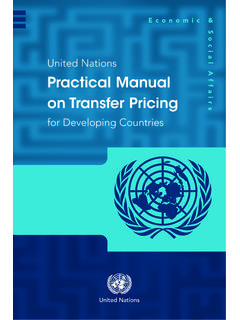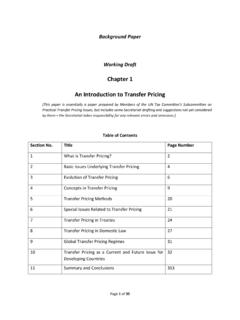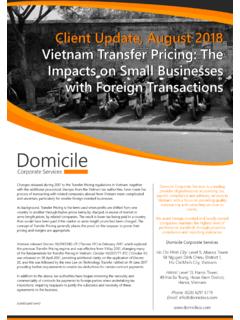Transcription of REPORT ON THE TRANSFER PRICING ASPECTS OF …
1 ORGANISATION FOR ECONOMIC CO-OPERATION AND DEVELOPMENT REPORT ON THE TRANSFER PRICING ASPECTS OF BUSINESS RESTRUCTURINGS CHAPTER IX OF THE TRANSFER PRICING GUIDELINES 22 July 2010 CENTRE FOR TAX POLICY AND ADMINISTRATION FOREWORD This REPORT was approved by the Committee on Fiscal Affairs on 22 June 2010 and by the OECD Council on 22 July 2010. The Recommendation of the Council on the Determination of TRANSFER PRICING between Associated Enterprises [C(95)126/FINAL] was amended on 22 July 2010 to take account of the addition of the attached new Chapter IX and concomitant revision of Chapters I-III of the OECD TRANSFER PRICING Guidelines for Multinational Enterprises and Tax Administrations. 2 TABLE OF CONTENTS Chapter IX TRANSFER PRICING ASPECTS of Business Restructurings .. 4 Introduction .. 4 A. Scope .. 4 Business restructurings that are within the scope of this chapter .. 4 Issues that are within the scope of this chapter .. 5 B. Applying Article 9 of the OECD Model Tax Convention and these Guidelines to business restructurings: theoretical framework.
2 5 Part I: Special considerations for risks .. 6 A. Introduction .. 6 B. Contractual terms .. 6 Whether the conduct of the associated enterprises conforms to the contractual allocation of risks .. 7 Determining whether the allocation of risks in the controlled transaction is arm s length .. 7 What the consequences of the risk allocation are .. 12 C. Compliance issues .. 14 Part II: Arm s length compensation for the restructuring itself .. 15 A. Introduction .. 15 B. Understanding the restructuring itself .. 15 Identifying the restructuring transactions: functions, assets and risks before and after the restructuring .. 16 Understanding the business reasons for and the expected benefits from the restructuring, including the role of synergies .. 16 Other options realistically available to the parties .. 17 C. Reallocation of profit potential as a result of a business restructuring .. 18 Profit potential .. 18 Reallocation of risks and profit 18 D.
3 TRANSFER of something of value ( an asset or an ongoing concern) .. 20 Tangible assets .. 20 Intangible assets .. 22 TRANSFER of activity (ongoing concern) .. 25 Outsourcing .. 26 E. Indemnification of the restructured entity for the termination or substantial renegotiation of existing arrangements .. 26 Whether the arrangement that is terminated, non-renewed or 3 substantially renegotiated is formalised in writing and provides for an indemnification clause .. 27 Whether the terms of the arrangement and the existence or non-existence of an indemnification clause or other type of guarantee (as well as the terms of such a clause where it exists) are arm s length .. 28 Whether indemnification rights are provided for by commercial legislation or case law .. 30 Whether at arm s length another party would have been willing to indemnify the one that suffers from the termination or re-negotiation of the agreement .. 30 Part III: Remuneration of post-restructuring controlled transactions.
4 32 A. Business restructurings versus structuring .. 32 General principle: no different application of the arm s length principle .. 32 Possible factual differences between situations that result from a restructuring and situations that were structured as such from the beginning .. 32 B. Application to business restructuring situations: selection and application of a TRANSFER PRICING method for the post-restructuring controlled transactions .. 34 C. Relationship between compensation for the restructuring and post-restructuring remuneration .. 35 D. Comparing the pre- and post-restructuring situations .. 36 E. Location savings .. 37 F. Example: implementation of a central purchasing function .. 38 Part IV: Recognition of the actual transactions 40 A. Introduction .. 40 B. Transactions actually undertaken. Role of contractual terms. Relationship between paragraphs and other parts of these Guidelines .. 40 C. Application of paragraphs of these Guidelines to business restructuring situations.
5 41 Non-recognition only in exceptional cases .. 41 Determining the economic substance of a transaction or arrangement .. 42 Determining whether arrangements would have been adopted by independent enterprises .. 42 Determining whether a transaction or arrangement has an arm s length PRICING solution .. 43 Relevance of tax purpose .. 44 Consequences of non-recognition under paragraphs to .. 44 D. Examples .. 45 Example (A): Conversion of a full-fledged distributor into a risk-less distributor .. 45 Example (B): TRANSFER of valuable intangibles to a shell company .. 45 Example (C): TRANSFER of intangible that is recognised .. 46 4 Chapter IX TRANSFER PRICING ASPECTS of Business Restructurings Introduction A. Scope Business restructurings that are within the scope of this chapter There is no legal or universally accepted definition of business restructuring. In the context of this chapter, business restructuring is defined as the cross-border redeployment by a multinational enterprise of functions, assets and/or risks.
6 A business restructuring may involve cross-border transfers of valuable intangibles, although this is not always the case. It may also or alternatively involve the termination or substantial renegotiation of existing arrangements. Business restructurings that are within the scope of this chapter primarily consist of internal reallocation of functions, assets and risks within an MNE, although relationships with third parties ( suppliers, sub-contractors, customers) may also be a reason for the restructuring and/or be affected by it. Since the mid-90 s, business restructurings have often involved the centralisation of intangible assets and of risks with the profit potential attached to them. They have typically consisted of: Conversion of full-fledged distributors into limited-risk distributors or commissionnaires for a foreign associated enterprise that may operate as a principal, Conversion of full-fledged manufacturers into contract-manufacturers or toll-manufacturers for a foreign associated enterprise that may operate as a principal, Transfers of intangible property rights to a central entity ( a so-called IP company ) within the group.
7 There are also business restructurings whereby more intangibles and/or risks are allocated to operational entities ( to manufacturers or distributors). Business restructurings can also consist of the rationalisation, specialisation or de-specialisation of operations (manufacturing sites and / or processes, research and development activities, sales, services), including the downsizing or closing of operations. The arm s length principle and guidance in this chapter apply in the same way to all types of business restructuring transactions that fall within the definition given at paragraph , irrespective of whether they lead to a more centralised or less centralised business model. Business representatives who participated in the OECD consultation process in 2005-2009 explained that among the business reasons for restructuring are the wish to maximise synergies and economies of scale, to streamline the management of business lines and to improve the efficiency of the supply chain, taking advantage of the development of Internet-based technologies that has facilitated the emergence of global organisations.
8 They also indicated that business restructurings may be needed to preserve profitability or limit losses in a downturn economy, in the event of an over-capacity situation. 5 Issues that are within the scope of this chapter This chapter contains a discussion of the TRANSFER PRICING ASPECTS of business restructurings, of the application of Article 9 (Associated enterprises) of the OECD Model Tax Convention and of these Guidelines to business restructurings. Business restructurings are typically accompanied by a reallocation of profits among the members of the MNE group, either immediately after the restructuring or over a few years. One major objective of this chapter in relation to Article 9 is to discuss the extent to which such a reallocation of profits is consistent with the arm s length principle and more generally how the arm s length principle applies to business restructurings. The implementation of integrated business models and the development of global organisations, where they are done for bona fide commercial reasons, highlight the difficulty of reasoning in the arm s length theoretical environment which treats members of an MNE group as if they were independent parties.
9 This conceptual difficulty with applying the arm s length principle in practice is acknowledged in these Guidelines (see paragraphs ). Notwithstanding this problem, these Guidelines reflect the OECD Member countries strong support for the arm s length principle and for efforts to describe its application and refine its operation in practice (see paragraphs ). When discussing the issues that arise in the context of business restructuring, the OECD has kept this conceptual difficulty in mind in an attempt to develop approaches that are realistic and reasonably pragmatic. This chapter only covers transactions between associated enterprises in the context of Article 9 of the OECD Model Tax Convention and does not address the attribution of profits within a single enterprise on the basis of Article 7 of the OECD Model Tax Convention, as this is the subject of WP6 s REPORT on the Attribution of Profits to Permanent The guidance that is provided under Article 9 has been developed independently from the Authorised OECD Approach ( AOA ) that was developed for Article 7.
10 Domestic anti-abuse rules and CFC legislation are not within the scope of this chapter. The domestic tax treatment of an arm s length payment, including rules regarding the deductibility of such a payment and how domestic capital gains tax provisions may apply to an arm s length capital payment, are also not within the scope of this chapter. Moreover, while they raise important issues in the context of business restructurings, VAT and indirect taxes are not covered in this chapter. B. Applying Article 9 of the OECD Model Tax Convention and these Guidelines to business restructurings: theoretical framework This chapter starts from the premise that the arm s length principle and these Guidelines do not and should not apply differently to restructurings or post-restructuring transactions than to transactions that were structured as such from the beginning. The relevant question under Article 9 of the OECD Model Tax Convention and the arm s length principle is whether there are conditions made or imposed in a business restructuring that differ from the conditions that would be made between independent enterprises.















